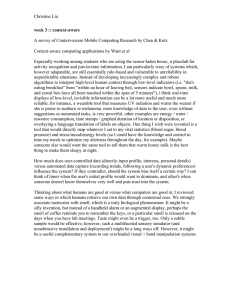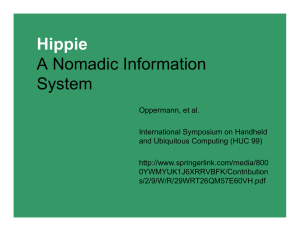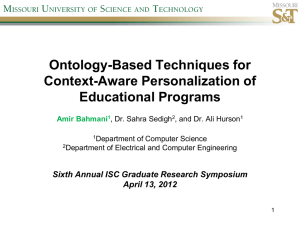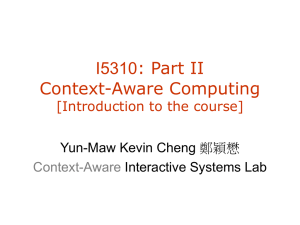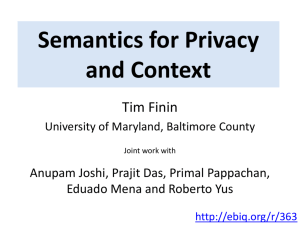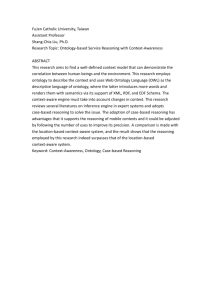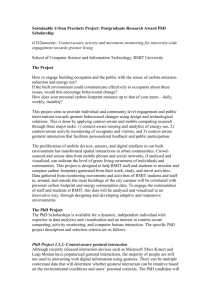Usability in Context-Aware Applications Anind K. Dey
advertisement
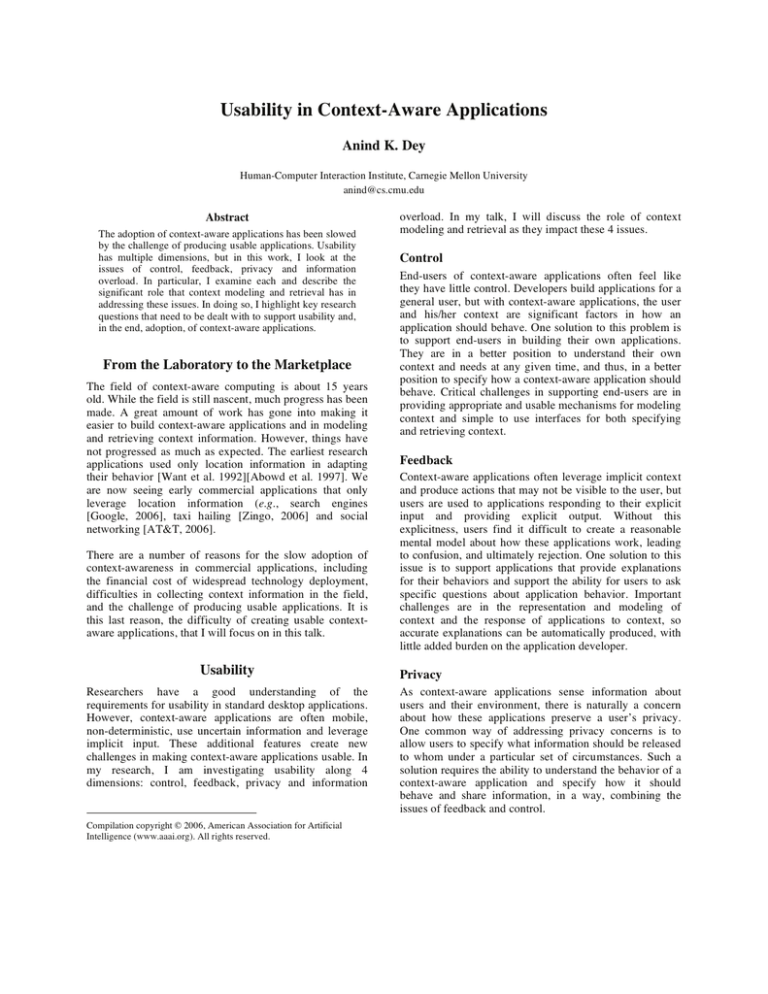
Usability in Context-Aware Applications Anind K. Dey Human-Computer Interaction Institute, Carnegie Mellon University anind@cs.cmu.edu Abstract The adoption of context-aware applications has been slowed by the challenge of producing usable applications. Usability has multiple dimensions, but in this work, I look at the issues of control, feedback, privacy and information overload. In particular, I examine each and describe the significant role that context modeling and retrieval has in addressing these issues. In doing so, I highlight key research questions that need to be dealt with to support usability and, in the end, adoption, of context-aware applications. From the Laboratory to the Marketplace The field of context-aware computing is about 15 years old. While the field is still nascent, much progress has been made. A great amount of work has gone into making it easier to build context-aware applications and in modeling and retrieving context information. However, things have not progressed as much as expected. The earliest research applications used only location information in adapting their behavior [Want et al. 1992][Abowd et al. 1997]. We are now seeing early commercial applications that only leverage location information (e.g., search engines [Google, 2006], taxi hailing [Zingo, 2006] and social networking [AT&T, 2006]. There are a number of reasons for the slow adoption of context-awareness in commercial applications, including the financial cost of widespread technology deployment, difficulties in collecting context information in the field, and the challenge of producing usable applications. It is this last reason, the difficulty of creating usable contextaware applications, that I will focus on in this talk. Usability Researchers have a good understanding of the requirements for usability in standard desktop applications. However, context-aware applications are often mobile, non-deterministic, use uncertain information and leverage implicit input. These additional features create new challenges in making context-aware applications usable. In my research, I am investigating usability along 4 dimensions: control, feedback, privacy and information Compilation copyright © 2006, American Association for Artificial Intelligence (www.aaai.org). All rights reserved. overload. In my talk, I will discuss the role of context modeling and retrieval as they impact these 4 issues. Control End-users of context-aware applications often feel like they have little control. Developers build applications for a general user, but with context-aware applications, the user and his/her context are significant factors in how an application should behave. One solution to this problem is to support end-users in building their own applications. They are in a better position to understand their own context and needs at any given time, and thus, in a better position to specify how a context-aware application should behave. Critical challenges in supporting end-users are in providing appropriate and usable mechanisms for modeling context and simple to use interfaces for both specifying and retrieving context. Feedback Context-aware applications often leverage implicit context and produce actions that may not be visible to the user, but users are used to applications responding to their explicit input and providing explicit output. Without this explicitness, users find it difficult to create a reasonable mental model about how these applications work, leading to confusion, and ultimately rejection. One solution to this issue is to support applications that provide explanations for their behaviors and support the ability for users to ask specific questions about application behavior. Important challenges are in the representation and modeling of context and the response of applications to context, so accurate explanations can be automatically produced, with little added burden on the application developer. Privacy As context-aware applications sense information about users and their environment, there is naturally a concern about how these applications preserve a user’s privacy. One common way of addressing privacy concerns is to allow users to specify what information should be released to whom under a particular set of circumstances. Such a solution requires the ability to understand the behavior of a context-aware application and specify how it should behave and share information, in a way, combining the issues of feedback and control. Information Overload Most developers of context-aware applications view their applications as being used in isolation from other applications. In the future, this assumption will be incorrect, with any number of context-aware applications vying for the user’s attention at any given time. An understanding of what the user is paying attention to, what is important to the user, and how best to convey information to the user is critical in deciding the priority of different applications. A much more detailed model of user and information context is required to satisfy these requirements, in order to not overload the user with information. Summary In my talk, I will discuss usability of context-aware applications, focusing on the issues of control, feedback, privacy and information overload. For each of these issues, support for modeling and retrieval of context is critical in producing usable context-aware applications. References Abowd, G.D., Atkeson, C.G., Hong, J., Long, S., Kooper, R. and Pinkerton, M. 1997. CyberGuide: A Mobile Context-aware Tour Guide. ACM Wireless Networks, 3:421-433. AT&T. 2006. http://www.attwireless.com AT&T Friendfinder, Google. 2006. Google Maps. http://local.google.com Want, R., Hopper, A., Falcao., V. and Gibbons, J. 1992. The Active Badge Location System. ACM Transactions on Information Systems, 10(1):91-102. Zingo Taxi, Inc. http://www.zingotaxi.co.uk 2006. Zingo Taxi,
